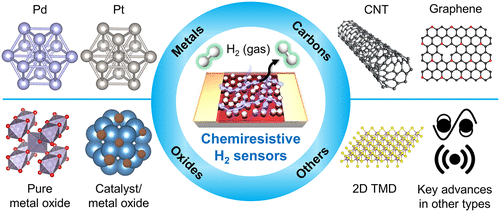Our official English website, www.x-mol.net, welcomes your
feedback! (Note: you will need to create a separate account there.)
Chemiresistive Hydrogen Sensors: Fundamentals, Recent Advances, and Challenges
ACS Nano ( IF 15.8 ) Pub Date : 2020-10-30 , DOI: 10.1021/acsnano.0c05307 Won-Tae Koo 1 , Hee-Jin Cho 1 , Dong-Ha Kim 1 , Yoon Hwa Kim 1 , Hamin Shin 1 , Reginald M. Penner 2 , Il-Doo Kim 1
ACS Nano ( IF 15.8 ) Pub Date : 2020-10-30 , DOI: 10.1021/acsnano.0c05307 Won-Tae Koo 1 , Hee-Jin Cho 1 , Dong-Ha Kim 1 , Yoon Hwa Kim 1 , Hamin Shin 1 , Reginald M. Penner 2 , Il-Doo Kim 1
Affiliation

|
Hydrogen (H2) is one of the next-generation energy sources because it is abundant in nature and has a high combustion efficiency that produces environmentally benign products (H2O). However, H2/air mixtures are explosive at H2 concentrations above 4%, thus any leakage of H2 must be rapidly and reliably detected at much lower concentrations to ensure safety. Among the various types of H2 sensors, chemiresistive sensors are one of the most promising sensing systems due to their simplicity and low cost. This review highlights the advances in H2 chemiresistors, including metal-, semiconducting metal oxide-, carbon-based materials, and other materials. The underlying sensing mechanisms for different types of materials are discussed, and the correlation of sensing performances with nanostructures, surface chemistry, and electronic properties is presented. In addition, the discussion of each material emphasizes key advances and strategies to develop superior H2 sensors. Furthermore, recent key advances in other types of H2 sensors are briefly discussed. Finally, the review concludes with a brief outlook, perspective, and future directions.
中文翻译:

耐化学氢传感器:基本原理,最新进展和挑战
氢(H 2)是自然界中的丰富能源,具有高燃烧效率,可产生对环境无害的产品(H 2 O),是下一代能源之一。但是,H 2 /空气混合物在H 2浓度高于4%时具有爆炸性,因此必须以低得多的浓度快速可靠地检测到H 2的任何泄漏,以确保安全。在各种类型的H 2传感器中,化学电阻传感器由于其简单性和低成本而成为最有前途的传感系统之一。这篇评论突出了H 2的进展化学电阻,包括金属,半导体金属氧化物,碳基材料和其他材料。讨论了针对不同类型材料的潜在传感机制,并提出了传感性能与纳米结构,表面化学和电子特性之间的相关性。此外,每种材料的讨论都强调了开发高级H 2传感器的关键进展和策略。此外,简要讨论了其他类型的H 2传感器的最新关键进展。最后,回顾以一个简短的展望,观点和未来方向结束。
更新日期:2020-11-25
中文翻译:

耐化学氢传感器:基本原理,最新进展和挑战
氢(H 2)是自然界中的丰富能源,具有高燃烧效率,可产生对环境无害的产品(H 2 O),是下一代能源之一。但是,H 2 /空气混合物在H 2浓度高于4%时具有爆炸性,因此必须以低得多的浓度快速可靠地检测到H 2的任何泄漏,以确保安全。在各种类型的H 2传感器中,化学电阻传感器由于其简单性和低成本而成为最有前途的传感系统之一。这篇评论突出了H 2的进展化学电阻,包括金属,半导体金属氧化物,碳基材料和其他材料。讨论了针对不同类型材料的潜在传感机制,并提出了传感性能与纳米结构,表面化学和电子特性之间的相关性。此外,每种材料的讨论都强调了开发高级H 2传感器的关键进展和策略。此外,简要讨论了其他类型的H 2传感器的最新关键进展。最后,回顾以一个简短的展望,观点和未来方向结束。











































 京公网安备 11010802027423号
京公网安备 11010802027423号